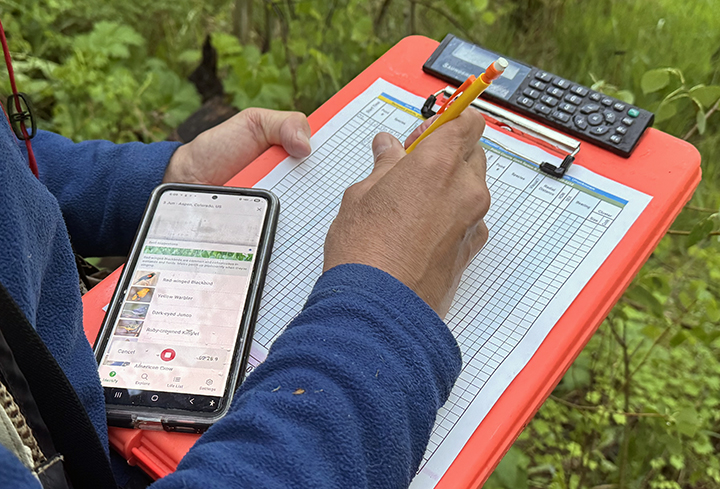North Star alive with the sound of birds

A female Mountain bluebird at North Star.
On the far west side of North Star Nature Preserve, the vegetation closes in like a jungle. Overnight rain still drips from every leaf, and in dawn’s early light, the clouds hang low over the upper Roaring Fork Valley. It’s a part of North Star that rarely sees a human visitor. On occasion, access is granted for research or stewardship. Today, we’re conducting a formal scientific survey of “avifauna,” aka birds.
More specifically, we’re listening for birds, as actually spotting anything in the verdant tangle of trees and shrubs where the Preserve abuts the eastern flank of Aspen Mountain is nearly impossible. Still, the habitat’s polyphonic chorus was putting the Merlin birdsong app on my phone to the test. Wilson’s snipe, Dark-eyed Junco, Yellow warbler, Red-winged blackbird, Ruby-crowned kinglet, Sora … and the list kept going.
Jonathan Lowsky, wildlife biologist with Colorado Wildlife Science in Basalt, is scribbling furiously, logging each call. He recognizes each of them by ear, but uses the phone app to compare notes. For a five-minute interval, each song and occasional sighting is noted. The protocol is one developed by the Bird Conservancy of the Rockies (formerly Rocky Mountain Bird Observatory) and used across the state.
Lowsky, who conducts wildlife surveys at various open space properties on behalf of Pitkin County Open Space and Trails, isn’t surprised by the swelling chorus of chirps, trills and harmonic warbles. He declares North Star the most biologically diverse open space in the county’s ownership – “a gem,” he says.
For me, the delight is the “descending whinny” of the Sora, a marshland bird that is more readily heard than seen. Its delightful burst of quick notes, descending in scale and speed, is unlike any other in the menagerie of songs. It really does sound jungle-like.
In addition to informal bird censuses and anecdotal contributions by involved community members since the 1970s (thank you Mark Fuller, Rebecca Weiss, Charlie Hopton and other birders!), OST has conducted formal, scientific census surveys at regular intervals at North Star since 2001, making our understanding of the avian species present there quite robust. Birds were last formally surveyed in 2017 and 2020-21. The formal surveys are done on early June mornings, when migratory species have returned, and breeding and nesting activities are in full swing. Guided by GPS, Lowsky makes his way to 17 established points sited in the Preserve’s varied vegetative habitat types, many of which are the same points that have been monitored since the 1990s.
Avifauna extends beyond songbirds, however, and separate survey efforts are conducted to detect nocturnal birds and raptors. Lowsky follows a widely used protocol that employs recordings at night to entice a response from species such as owls. A similar tactic is used during daylight hours to detect raptors such as hawks at nine designated locations at North Star.
Forty-nine species were detected this year, including the first-ever documentation of a Willow flycatcher during a survey. Since 2001, 93 avian species have been documented during surveys at North Star, including the newly logged flycatcher. While yet other species have been observed at the Preserve, only birds documented during the formal surveys are included on the official bird tally.
Similarly, other wildlife, plant communities and aquatic elements are analyzed on a regular basis at North Star. A wildlife survey is also being conducted this year. The results of the fieldwork will be detailed in a report to follow.
The bird surveys provide Pitkin County Open Space and Trails and the public with information about North Star’s avian diversity and their habitat. Changes in bird species composition and density can be used to assess habitat quality. Many birds are only seasonal residents at North Star, so there are a multitude of factors across the region and globe that impact bird populations overall.
All of the monitoring efforts, at North Star and on other open spaces, provide information for “adaptive management” of natural resources – a process that requires regular monitoring and evaluation, and the flexibility to adapt management actions in response to new information. The wetland fen restoration and the implementation of stricter rules at North Star are examples of actions that have been taken in response to data collected by our ecological surveys. This iterative, informed approach guides Open Space and Trails in adjusting its management of resources as conditions dictate.
– By Janet Urquhart, Pitkin County Open Space and Trails
KEY LINK
North Star Nature Preserve Wildlife Monitoring Report ̶ 2020-2021 Field Seasons

Logging bird calls at North Star Nature Preserve.
